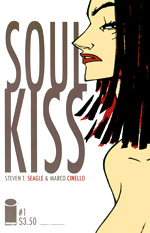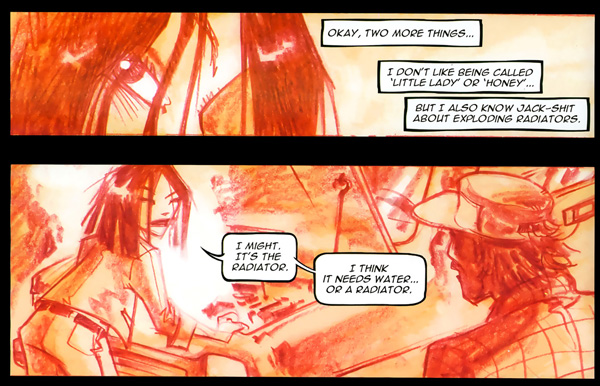 Written by Steven T. Seagle
Written by Steven T. Seagle
Art by Marco Cinello
28 pages, color
Published by Image Comics
I’ve been reading Steven T. Seagle’s comics for a really long time, and the one thing that has connected them all is an apparent willingness to keep from being pigeon-holed into a single genre or style. So while Soul Kiss may not have any specific hook or twist that you’re used to seeing in lots of other Seagle books, I somehow couldn’t help but feel that it was recognizably written by him. I guess when the closest you can get to a writing trait is, "Anything can happen," that’s not really a bad thing at all.
Lili is a Hollywood production assistant, but that’s not important right now. She’s also contemplating graduate school, but that’s also not important right now. What is important is that Lili made a deal with the devil in order to survive an attacker, but now she’s discovering that her deal isn’t over and done with. So while Lili survived unharmed, she may have accidentally thrown away one of the few good things in her life.

Seagle’s script for Soul Kiss #1 is all set-up, laying out the road for everything still to come in the comic. We see Lili’s horrible job, the even worse encounter in the desert, and her relationship with her boyfriend Damon. He does a really good job of bringing Lili’s world to life for us, showing its ups and downs; by having the book told in a first person narration, it’s that much easier to get inside of Lili’s head. Comments like, "I never fail. Never. But I did…" do a good job of bringing out Lili’s anguish at everything that went wrong with her day and the ill-fated interview trip, and begin to show the cracks in her otherwise tough-as-nails exterior. My only real complaint with the writing is that it made me slightly wish for this to have been written strictly as a graphic novel, because things are just starting to get rolling when we’re at the end of the issue. It’s amazing how spoiled one can be when it comes to cliffhangers, these days.
Marco Cinello’s art is new to me, but I really like it. Cinello uses two different styles for illustrating Soul Kiss, and each of them fits perfectly with what Seagle’s trying to accomplish with his scripts. The flashback scenes, as Lili reflects on what brought her to her current state, are very rough and loose, almost as if they were drawn in crayon. Don’t mistake that style for being unprofessional or ill-fitting, though; the more you look at Cinello’s art in this style the more you will see how much care and craft has gone into them. From the horrific moment in the desert where everything goes wrong, to the appearance of the devil, every single character looks very distinct and visually interesting. Lili’s attacker’s stubble and leer pops out at the reader, and the devil’s shroud of red and slowly emerging red horns ends up looking much creepier than any standard depiction of the character could have looked like.

We also get a few sequences with a crisper, more finished style. These work well too, even as they’re still very recognizably by the same artist who drew the rest of the book. The lines are now containing solid shapes instead of jagged swipes of color, and it’s a very attractive look that reminds me a bit of modern animation. It may sound a little surprising but at first I was actually a tiny bit disappointed that Cinello was using this more traditional style in Soul Kiss as well, I’d grown so accustomed to what he did in the rest of the book. The more I looked at the rest of the art, though, the more I appreciated it as well. He’s able to work with the smaller background details here, from funky lampshades to an attractive bedspread.
Soul Kiss #1 is a good start to this five-issue mini-series, but like I said before, the one downside is that it stops right when it really gets going. If you read interviews with Seagle you can find out what the rest of the thrust of the mini-series will be, and it sounds more than interesting enough that I’m definitely on board for the rest. If you haven’t read those interviews, though, I’d actually recommend avoiding them and just planning on buying the next issue so you can see for yourself what Seagle and Cinello have in store. There’s a lot of promise, here, and so far it’s paying off quite nicely.
